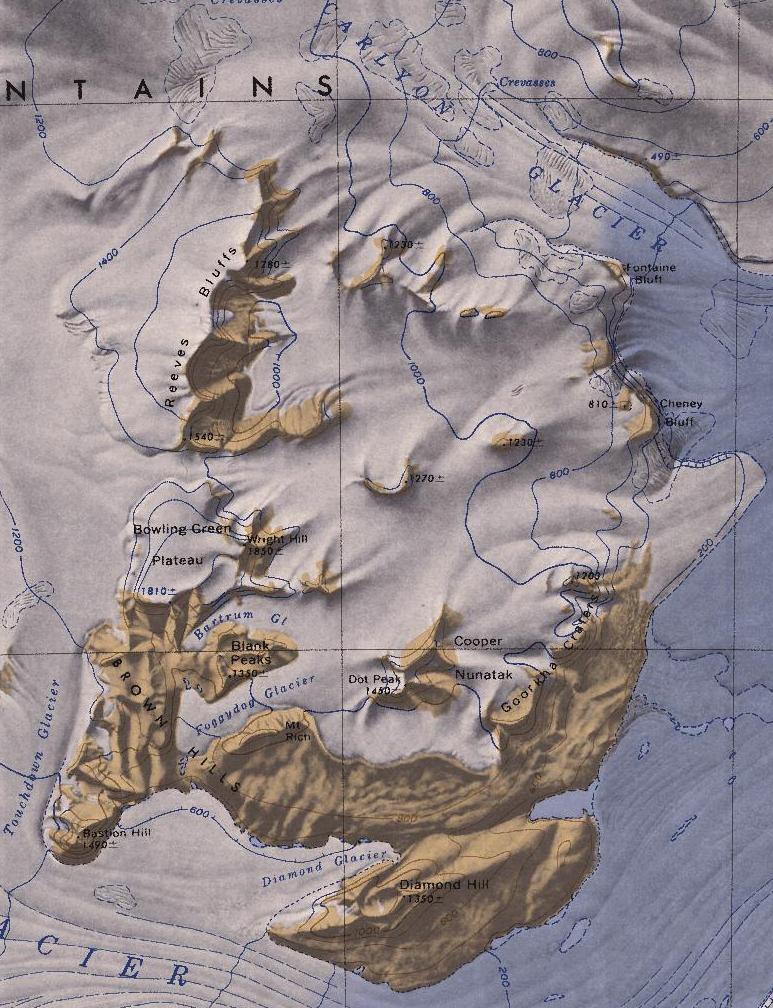|
Relief Pass
Relief Pass () is a pass, about 1,000 m high, situated 1 nautical mile (1.9 km) north of Bastion Hill in the Brown Hills. Explored by the Victoria University of Wellington Antarctic Expedition The Antarctic Research Centre (ARC) is part of the School of Geography, Environment and Earth Sciences at Victoria University of Wellington. Its mission is to research "Antarctic climate history and processes, and their influence on the global clima ... (VUWAE), 1962–63, and so named by its members because of the relief it provided after ascent to this pass. References Mountain passes of Antarctica Landforms of Oates Land {{OatesLand-geo-stub ... [...More Info...] [...Related Items...] OR: [Wikipedia] [Google] [Baidu] |
Bastion Hill
Bastion Hill () is a prominent ice-free feature in the Brown Hills of Antarctica, rising to and projecting southward into Darwin Glacier just east of Touchdown Glacier. The descriptive name, the hill supposedly suggesting a bastion, was given by the Darwin Glacier Party of the Commonwealth Trans-Antarctic Expedition (1956–58). Localities *Relief Pass Relief Pass () is a pass, about 1,000 m high, situated 1 nautical mile (1.9 km) north of Bastion Hill in the Brown Hills. Explored by the Victoria University of Wellington Antarctic Expedition The Antarctic Research Centre (ARC) is part of t ... References * Hills of Oates Land {{OatesLand-geo-stub ... [...More Info...] [...Related Items...] OR: [Wikipedia] [Google] [Baidu] |
Brown Hills
The Brown Hills () are a group of mainly snow-free hills in the Cook Mountains of Antarctica. Location The Brown Hills lie north of the lower reaches of Darwin Glacier. They are north of Diamond Hill and are adjacent to Diamond Glacier, a distributary of the Darwin Glacier. To the east they are bordered by the Ross Ice Shelf. On the west side, the Touchdown Glacier flows south to the Darwin Glacier between Roadend Nunatak and the Brown Hills. Reeves Bluffs are to the north of the hills. The hills were named for their color by the Darwin Glacier Party of the Commonwealth Trans-Antarctic Expedition (1956–58). Geology During glacial periods, Diamond Glacier would probably have flowed over the Brown Hills to the Ross Ice Shelf. Exposure ages of five glacial erratics from the Brown Hills range from 7,000 to 205,000 years ago, which implies that until 7,000 years ago the Brown Hills saddle was ice-covered. Simpson 2002 proposes that the Darwin calcic suite, a K-series, I-ty ... [...More Info...] [...Related Items...] OR: [Wikipedia] [Google] [Baidu] |
Victoria University Of Wellington Antarctic Expedition
The Antarctic Research Centre (ARC) is part of the School of Geography, Environment and Earth Sciences at Victoria University of Wellington. Its mission is to research "Antarctic climate history and processes, and their influence on the global climate system. The current director of the Antarctic Research Centre is Associate Professor Robert McKay. Directors * 1972 - 2007: Professor Peter Barrett * 2008 - 2016: Professor Tim Naish * 2017 - 2019: Professor Andrew Mackintosh * 2020 - Present: Professor Robert McKay History In December 1957, geology students Barrie McKelvey and Peter Webb along with biologist Ron Balham conducted an expedition to the then unexplored McMurdo Dry Valleys via the Royal New Zealand Navy Antarctic support ship HMNZS ''Endeavour''. This expedition formed the basic for the annual Victoria University of Wellington Antarctic Expeditions, which continue to the present day. Since this first expedition, over 400 staff and students have travelled to the ... [...More Info...] [...Related Items...] OR: [Wikipedia] [Google] [Baidu] |
Mountain Passes Of Antarctica
A mountain is an elevated portion of the Earth's crust, generally with steep sides that show significant exposed bedrock. Although definitions vary, a mountain may differ from a plateau in having a limited summit area, and is usually higher than a hill, typically rising at least 300 metres (1,000 feet) above the surrounding land. A few mountains are isolated summits, but most occur in mountain ranges. Mountains are formed through tectonic forces, erosion, or volcanism, which act on time scales of up to tens of millions of years. Once mountain building ceases, mountains are slowly leveled through the action of weathering, through slumping and other forms of mass wasting, as well as through erosion by rivers and glaciers. High elevations on mountains produce colder climates than at sea level at similar latitude. These colder climates strongly affect the ecosystems of mountains: different elevations have different plants and animals. Because of the less hospitable terrain and ... [...More Info...] [...Related Items...] OR: [Wikipedia] [Google] [Baidu] |

